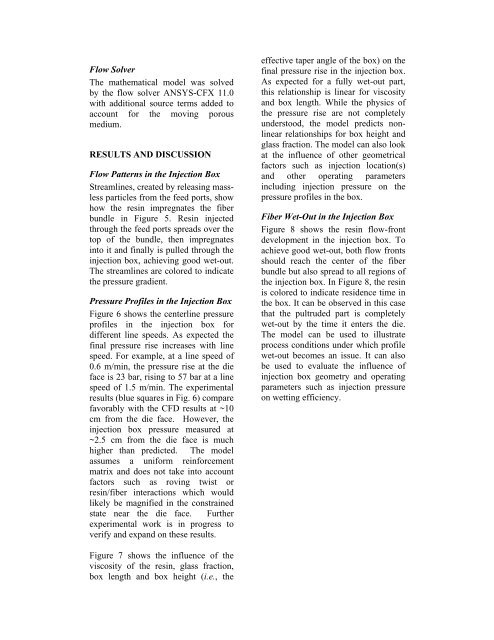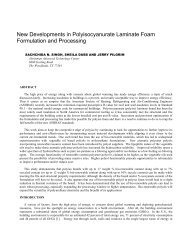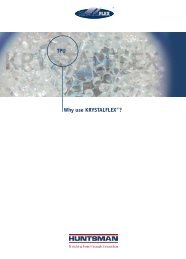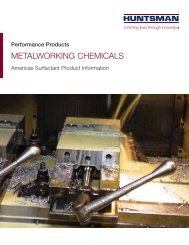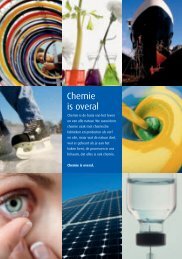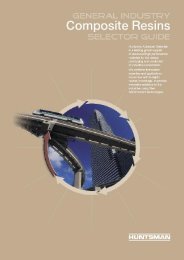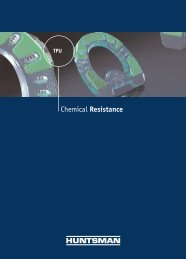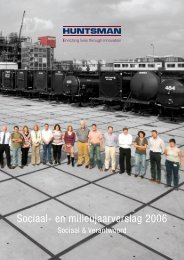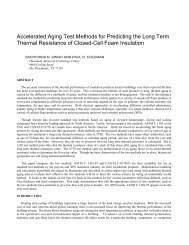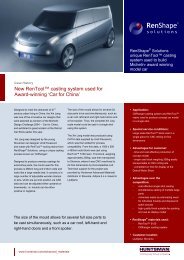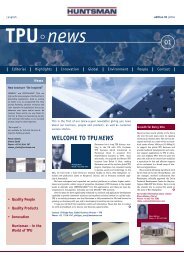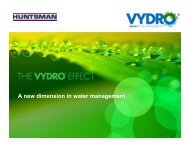CFD Modeling of the Closed Injection Wet-Out Process For Pultrusion
CFD Modeling of the Closed Injection Wet-Out Process For Pultrusion
CFD Modeling of the Closed Injection Wet-Out Process For Pultrusion
Create successful ePaper yourself
Turn your PDF publications into a flip-book with our unique Google optimized e-Paper software.
Flow Solver<br />
The ma<strong>the</strong>matical model was solved<br />
by <strong>the</strong> flow solver ANSYS-CFX 11.0<br />
with additional source terms added to<br />
account for <strong>the</strong> moving porous<br />
medium.<br />
RESULTS AND DISCUSSION<br />
Flow Patterns in <strong>the</strong> <strong>Injection</strong> Box<br />
Streamlines, created by releasing massless<br />
particles from <strong>the</strong> feed ports, show<br />
how <strong>the</strong> resin impregnates <strong>the</strong> fiber<br />
bundle in Figure 5. Resin injected<br />
through <strong>the</strong> feed ports spreads over <strong>the</strong><br />
top <strong>of</strong> <strong>the</strong> bundle, <strong>the</strong>n impregnates<br />
into it and finally is pulled through <strong>the</strong><br />
injection box, achieving good wet-out.<br />
The streamlines are colored to indicate<br />
<strong>the</strong> pressure gradient.<br />
Pressure Pr<strong>of</strong>iles in <strong>the</strong> <strong>Injection</strong> Box<br />
Figure 6 shows <strong>the</strong> centerline pressure<br />
pr<strong>of</strong>iles in <strong>the</strong> injection box for<br />
different line speeds. As expected <strong>the</strong><br />
final pressure rise increases with line<br />
speed. <strong>For</strong> example, at a line speed <strong>of</strong><br />
0.6 m/min, <strong>the</strong> pressure rise at <strong>the</strong> die<br />
face is 23 bar, rising to 57 bar at a line<br />
speed <strong>of</strong> 1.5 m/min. The experimental<br />
results (blue squares in Fig. 6) compare<br />
favorably with <strong>the</strong> <strong>CFD</strong> results at ~10<br />
cm from <strong>the</strong> die face. However, <strong>the</strong><br />
injection box pressure measured at<br />
~2.5 cm from <strong>the</strong> die face is much<br />
higher than predicted. The model<br />
assumes a uniform reinforcement<br />
matrix and does not take into account<br />
factors such as roving twist or<br />
resin/fiber interactions which would<br />
likely be magnified in <strong>the</strong> constrained<br />
state near <strong>the</strong> die face. Fur<strong>the</strong>r<br />
experimental work is in progress to<br />
verify and expand on <strong>the</strong>se results.<br />
Figure 7 shows <strong>the</strong> influence <strong>of</strong> <strong>the</strong><br />
viscosity <strong>of</strong> <strong>the</strong> resin, glass fraction,<br />
box length and box height (i.e., <strong>the</strong><br />
effective taper angle <strong>of</strong> <strong>the</strong> box) on <strong>the</strong><br />
final pressure rise in <strong>the</strong> injection box.<br />
As expected for a fully wet-out part,<br />
this relationship is linear for viscosity<br />
and box length. While <strong>the</strong> physics <strong>of</strong><br />
<strong>the</strong> pressure rise are not completely<br />
understood, <strong>the</strong> model predicts nonlinear<br />
relationships for box height and<br />
glass fraction. The model can also look<br />
at <strong>the</strong> influence <strong>of</strong> o<strong>the</strong>r geometrical<br />
factors such as injection location(s)<br />
and o<strong>the</strong>r operating parameters<br />
including injection pressure on <strong>the</strong><br />
pressure pr<strong>of</strong>iles in <strong>the</strong> box.<br />
Fiber <strong>Wet</strong>-<strong>Out</strong> in <strong>the</strong> <strong>Injection</strong> Box<br />
Figure 8 shows <strong>the</strong> resin flow-front<br />
development in <strong>the</strong> injection box. To<br />
achieve good wet-out, both flow fronts<br />
should reach <strong>the</strong> center <strong>of</strong> <strong>the</strong> fiber<br />
bundle but also spread to all regions <strong>of</strong><br />
<strong>the</strong> injection box. In Figure 8, <strong>the</strong> resin<br />
is colored to indicate residence time in<br />
<strong>the</strong> box. It can be observed in this case<br />
that <strong>the</strong> pultruded part is completely<br />
wet-out by <strong>the</strong> time it enters <strong>the</strong> die.<br />
The model can be used to illustrate<br />
process conditions under which pr<strong>of</strong>ile<br />
wet-out becomes an issue. It can also<br />
be used to evaluate <strong>the</strong> influence <strong>of</strong><br />
injection box geometry and operating<br />
parameters such as injection pressure<br />
on wetting efficiency.


